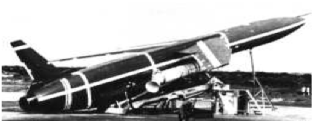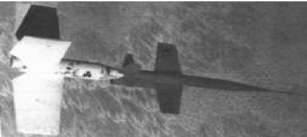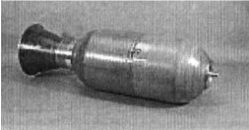Updated: 02-Jan-2020
Sometimes it has been written as "Allegheny". They made solid fuel rocket engines from 1600 lbs (T-21) to 90900 lbs like the X202B1.
-The first one was known as a "Kent" decelerator and the second was known to assist in launching missiles.
-They both use double base propellant without smoke.
-The T-30 that gave 12,500 lbs. was a trial engine. The T-39 was in development at the end of 1949 and already delivered 51,000 lbs of thrust.
-The 4DS-105000 was a larger engine with 105,000 lbs of thrust and it was used for launching guided missiles.
-Alleghany also provided both 130,000 lbs boosters that were used by the thermonuclear warhead missile "Snark" to assist launching. The main engine or cruise flight engine was a PW J57-P-17 with US Code: AB.
-The Antares II, X-259 was used in the third stage of the Scout missile.
-The companies Alleghany, Alliant and Hercules Powder, etc. are constantly confused but Hercules Powder joined Alleghany after WWII and today is known as Alliant Tech. Systems (ATK).
-Each of them was inheriting previous technology, its means and engines. Thus we see Antares II engines with the Hercules shield or logo when they already belonged to Alleghany.

“Antares II, at the NASM”
-This is a solid fuel engine with 23500 lbs of thrust. It is a member of the name string of stars that they used in this period such as Algol, Altair or Castor.
-The X-216A2 was mounted in the EXOS. The X-254 was mounted in the Antares 1A (Blue Strike Jr).
-From appendix 6: Now we show the Alleghany Antares 254 X-1 installed in the Blue Scout.
-In the third stage of the Blue Scout I with 13600 lbs of thrust for 39 seconds.

“Blue Scout I”
-The Blue Scout Junior also used X-254 Antares engines in its second stage with the same power.
-The Blue Scout Junior was the XRM-91 built by Ford.
-The SM-62 Snark cruising missile, powered by a Pratt and Whitney J-57 turbine, used two Alleghany solid fuel boosters with 130,000 lbs of thrust for 4 seconds. This missile was launched from a fixed spot on the surface.
-We see them along the fuselage in the following illustration.

“The Snark with Alleghany boosters”
-Another use of boosters was that of the spectacular winged X-202-C3 engine (the 4DW105000) that gave 105000 lbs of thrust during 4 seconds to launch the X-7A-1 missile. For its flight this missile used various types of ramjets.

“The Lockheed Martin X-7A-1”
-At the NASM we obtained a photo of the solid rocket engine that was used in the third stage of the Vanguard III, known as "Altai" with reference X-248-A2.

“The Alleghany Altai”
-The Vanguard III was launched in 1959 in a quick response to the Russian Sputnik I.
-The engine was built at Alleghany when it was still Hercules Inc and it delivered approximately 3000 lbs of thrust. It was made with a filament-wound fiber-reinforced epoxy resin that resulted in great resistance and lightweight.
Engines of ALLEGHANY BALLISTICS LAB
Model: 4DS-105000
Model: Altai, X-248-A2

"The Alleghany Altai"
Model: Antares 1, X-254
Model: El Antares II, X-259

"Antares II, at the NASM"
Model: T-21
Model: T-30
Model: T-39
Arquitecture:
Chambers: 0
Fuels: 0
Feed System:
Ignition:
Thrust: 51000 Lbf
Weight:
The T-39 was in development at the end of 1949.
Model: X-202-C3 (4DW105000)
Arquitecture: Rocket engine
Chambers: 0
Fuels: 0
Feed System:
Ignition:
Thrust:
Weight:
Another use of boosters was that of the spectacular winged X-202-C3 engine (the 4DW105000) that gave 105000 lbs of thrust during 4 seconds to launch the X-7A-1 missile.
Model: X-216A2
Model: X202B1
Arquitecture: Rocket engine
Chambers: 0
Fuels: 0
Feed System:
Ignition:
Thrust: 90900 Lbf
Weight:
This engine was used as missile launching aid.


